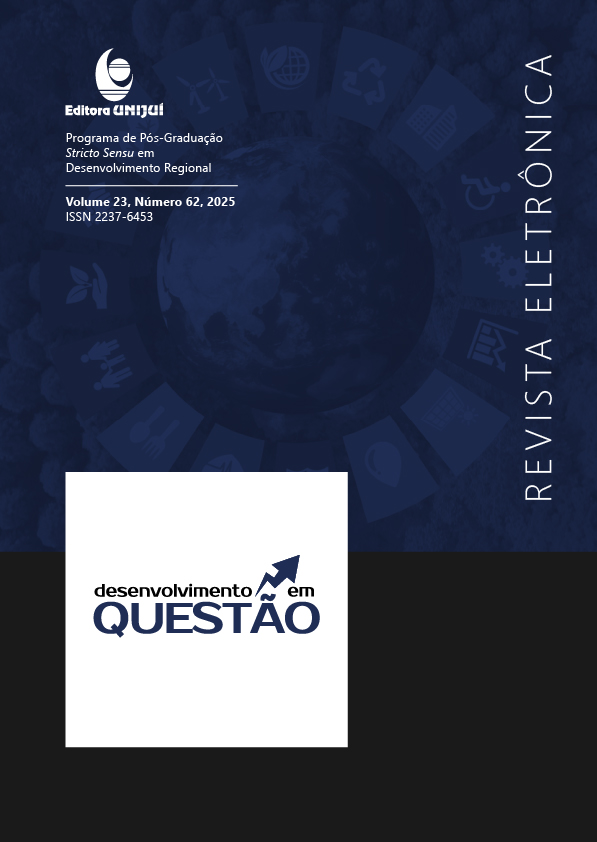Navigation and territorial occupation: The Iguaçu River in the regional economic formation of the northern plateau of Santa Catarina and southern Paraná
DOI:
https://doi.org/10.21527/2237-6453.2025.62.16152Keywords:
River expeditions, Iguaçu River, Territorial occupation, Economic developmentAbstract
This study analyzes the role of river expeditions in the Iguaçu River and its tributaries in the process of occupation and development of the northern Santa Catarina and southern Plateau of Paraná. The qualitative approach used is based on bibliographic and documentary research, complemented by a historiographical analysis of primary sources. Since the eighteenth century, military and scientific expeditions broke the territory, contributing to the riverside occupation and the river trade. The reports of these expeditions reveal how the Iguaçu River facilitated the transportation and regional economic integration, being crucial to the economic cycles of yerba mate and wood. Steam navigation, started in the 19th century, it further boosted economic development and the formation of municipalities along the river. The study also discusses the environmental impacts arising from navigation and the exploitation of natural resources along the Iguaçu River.
References
BAGGIO, Rogério João. Destino Cataratas do Iguaçu: novecentos quilômetros de caiaque e aventura. 1. ed. Curitiba/PR: Traços e Letras Editora, 2018.
BARDIN, Laurence. Análise de conteúdo. Lisboa: Edições 70, 2011.
BRANDT, Marlon. Uma história ambiental dos campos do planalto de Santa Catarina. 2012. Tese (Doutorado em História Cultural) - Universidade Federal de Santa Catarina, Florianópolis, 2012.
BRAUDEL, Fernand. A dinâmica do capitalismo. Rio de Janeiro: Rocco, 1997.
CASCAES, Domingos Lopes; FILGUEIRA, Bruno da Costa. Rellação sumaria da viagem que fizemos pelo Rio do Registro abayxo. Documentos Interessantes a História e Costumes de São Paulo: Correspondência do Capitão-General Dom Luiz Antônio de Souza 1767-1770, São Paulo, v. XIX, p. 347-352, 1896.
EHLKE, Cyro. A Conquista do Planalto Catarinense: bandeirantes e tropeiros do “sertão de curitiba”. Rio de Janeiro: Laudes, 1973.
GIL, Antonio Carlos. Métodos e técnicas de pesquisa social. 6. ed. São Paulo: Atlas, 2008.
GUIMARÃES, S. K.; MONASTIRSKY, L. B. A PRESERVAÇÃO DA MEMÓRIA DA HIDROVIA DO RIO IGUAÇU (PR). Caminhos de Geografia, Uberlândia, v. 19, n. 66, p. 157–168, 2018. Disponível em: https://seer.ufu.br/index.php/caminhosdegeografia/article/view/39081. Acesso em: 1 jul. 2024.
GOULARTI FILHO, Alcides. A estrada da mata e a integração regional pelo interior do brasil meridional. Textos de Economia, Florianópolis, v. 15, n. 2, p. 111-138, jul./dez. 2012.
GOULARTI FILHO, Alcides. Complexo ervateiro e a pequena produção mercantil em Santa Catarina. Diálogos, v. 16, n. 1, p. 179-215, jan./abr. 2012.
KARPINSKI, Cezar. Gentes e paisagens do rio Iguaçu na viagem expedicionária dos engenheiros Keller em 1866. Revista de História Regional. 17, 2012. Disponível em: 10.5212/Rev.Hist.Reg.v.17i1.0002. Acesso em: 01 jul. 2024.
KELLER, Josef; KELLER, Franz. Relatório da exploração do rio Iguassú feita em 1866. Relatório apresentado à Assembleia Legislativa do Paraná pelo Ministério da Agricultura, Rio de Janeiro. Anexo P, p.1-31, 1866. Disponível em: http://ddsnext.crl.edu/brazil. Acesso em: 22 abr. 2020.
INSTITUTO HISTÓRICO E GEOGRÁFICO BRASILEIRO (IHGB). Roteiro: Do certão e minas de Inhanguera, vindo da villa do Coritiba para ellas. Revista do Instituto Histórico e Geográfico Brasileiro, Rio de Janeiro, v. LXIX - Parte I, n. 113, p. 241-243, 1906.
OURIQUE, Alfredo Ernesto Jacques. Questão de limites entre Paraná e Santa Catarina. Conservador, Desterro, ano 5, n. 266, p.1, 24 nov. 1888.
OURIQUE, Alfredo Ernesto Jacques. Questão de limites entre Paraná e Santa Catarina. Conservador, Desterro, ano 5, n. 267, p.1, 26 nov. 1888.
POYER, Viviani. Fronteiras de uma Guerra: imigração, diplomacia e política internacional em meio ao movimento social do contestado 1907-1918. Tese (Doutorado em História Cultural) - Universidade Federal de Santa Catarina, Florianópolis, 2018. 350 p.
RIESEMBERG, Alvir. A instalação humana no vale do Iguaçu. Coleção Vale do Iguaçu da Faculdade Estadual de Filosofia, Ciências e Letras de União da Vitória-PR, 1973.
RIESEMBERG, Alvir. A Nau São Sebastião. Instituto Histórico, Geográfico e Etnográfico Paranaense, 1978.
RODRIGUES, Rogério Rosa. Conheça a história do município de Irineópolis. Sítio Eletrônico do Município de Irineópolis/SC, 2021. Disponível em: https://www.irineopolis.sc.gov.br/noticias/ver/2021/12/conheca-a-historia-do-municipio-de-irineopolis. Acesso em: 22 jun. 2023.
SANTOS, Milton. A natureza do espaço: Técnica e tempo, razão e emoção. São Paulo: Hucitec, 1996.
SILVA, M. L. S.; SOPELSA, R. A. O progresso veio de barco: Um estudo sobre a navegação a vapor no Rio Iguaçu e sua importância para o desenvolvimento da cidade de São Mateus do Sul - PR (1879 – 1953). Ateliê de História, 1(1), 137-145, 2013.
SOUZA, Almir Antônio de. Um viajante no Brasil Joanino: Auguste de Saint-Hilaire, o Caminho das Tropas, o mato e o campo, e os índios do Planalto Meridional. Mneme - Revista de Humanidades, Caicó/RN, v. 15, n. 35, jul./dez. 2014, p. 137-165.
TAUNAY, Alfredo d‘Escragnolle. Excursão no Rio Iguassu. Revista do Instituto Histórico e Geográfico Brasileiro, Rio de Janeiro, v. LIII, parte I, p. 215 - 241, 1890.
TOKARSKI, Fernando. Conheça a história do município de Canoinhas. In: PREFEITURA DE CANOINHAS. História de Canoinhas, 2002. Disponível em: https://pmc.sc.gov.br/pagina-3653/. Acesso em: 8 abr. 2023.
THOMÉ, Nilson. Caminhos de tropeiros nos séculos XVIII e XIX como fatores pioneiros de desbravamento do Contestado. DRd - Desenvolvimento Regional em debate, v. 2, n. 1, p. 5-30, 31 jul. 2012.
Downloads
Published
How to Cite
Issue
Section
License
Copyright (c) 2025 Development in Question Journal

This work is licensed under a Creative Commons Attribution 4.0 International License.
By publishing in Revista Desenvolvimento em Questão, authors agree to the following terms:
All works are published under the Creative Commons Attribution 4.0 International License (CC BY 4.0), which allows:
Sharing — to copy and redistribute the material in any medium or format;
Adaptation — to remix, transform, and build upon the material for any purpose, even commercially.
These permissions are irrevocable, provided that the following terms are respected:
Attribution — authors must be properly credited, a link to the license must be provided, and any changes made must be indicated.
No additional restrictions — no legal or technological measures may be applied that legally restrict others from doing anything the license permits.
Notices:
The license does not apply to elements that are in the public domain or covered by legal exceptions.
The license does not grant all necessary rights for specific uses (e.g., image rights, privacy, or moral rights).
The journal is not responsible for the opinions expressed in the articles, which are the sole responsibility of the authors. The Editor, with the support of the Editorial Board, reserves the right to suggest or request modifications when necessary.
Only original scientific articles presenting research results of interest that have not been previously published or simultaneously submitted to another journal with the same purpose will be accepted.
Mentions of trademarks or specific products are intended solely for identification purposes and do not imply any promotional relationship by the authors or the journal.
License Agreement (for articles published from 2025 onward): Authors retain the copyright to their article and grant Revista Desenvolvimento em Questão the right of first publication.











